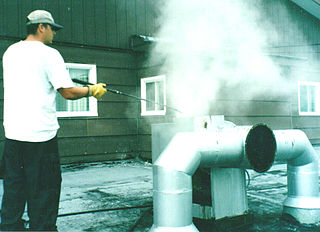Electrical wiring in North America follows regulations and standards for installation of building wiring which ultimately provides mains electricity.

The National Electrical Code (NEC), or NFPA 70, is a regionally adoptable standard for the safe installation of electrical wiring and equipment in the United States. It is part of the National Fire Code series published by the National Fire Protection Association (NFPA), a private trade association. Despite the use of the term "national", it is not a federal law. It is typically adopted by states and municipalities in an effort to standardize their enforcement of safe electrical practices. In some cases, the NEC is amended, altered and may even be rejected in lieu of regional regulations as voted on by local governing bodies.

Fire safety is the set of practices intended to reduce the destruction caused by fire. Fire safety measures include those that are intended to prevent ignition of an uncontrolled fire, and those that are used to limit the development and effects of a fire after it starts.
"NFPA 704: Standard System for the Identification of the Hazards of Materials for Emergency Response" is a standard maintained by the U.S.-based National Fire Protection Association. First "tentatively adopted as a guide" in 1960, and revised several times since then, it defines the colloquial "Safety Square" or "Fire Diamond" used by emergency personnel to quickly and easily identify the risks posed by hazardous materials. This helps determine what, if any, special equipment should be used, procedures followed, or precautions taken during the initial stages of an emergency response.
As the neutral point of an electrical supply system is often connected to earth ground, ground and neutral are closely related. Under certain conditions, a conductor used to connect to a system neutral is also used for grounding (earthing) of equipment and structures. Current carried on a grounding conductor can result in objectionable or dangerous voltages appearing on equipment enclosures, so the installation of grounding conductors and neutral conductors is carefully defined in electrical regulations. Where a neutral conductor is used also to connect equipment enclosures to earth, care must be taken that the neutral conductor never rises to a high voltage with respect to local ground.

The term high voltage usually means electrical energy at voltages high enough to inflict harm on living organisms. Equipment and conductors that carry high voltage warrant particular safety requirements and procedures. In certain industries, high voltage means voltage above a particular threshold (see below). High voltage is used in electrical power distribution, in cathode ray tubes, to generate X-rays and particle beams, to demonstrate arcing, for ignition, in photomultiplier tubes, and in high power amplifier vacuum tubes and other industrial, military and scientific applications.
The publication Life Safety Code, known as NFPA 101, is a consensus standard widely adopted in the United States. It is administered, trademarked, copyrighted, and published by the National Fire Protection Association and, like many NFPA documents, is systematically revised on a three-year cycle.

In electrical engineering, hazardous locations are defined as places where fire or explosion hazards may exist due to flammable gases, flammable liquid–produced vapors, combustible liquid–produced vapors, combustible dusts, or ignitable fibers/flyings present in the air in quantities sufficient to produce explosive or ignitable mixtures. Electrical equipment that must be installed in such classified locations should be specially designed and tested to ensure it does not initiate an explosion, due to arcing contacts or high surface temperature of equipment.

Lock Out, Tag Out (LOTO), Lock Out, Tag Out, Try Out (LOTOTO) or lock and tag is a safety procedure used in industry and research settings to ensure that dangerous machines are properly shut off and not able to be started up again prior to the completion of maintenance or repair work. It requires that hazardous energy sources be "isolated and rendered inoperative" before work is started on the equipment in question. The isolated power sources are then locked and a tag is placed on the lock identifying the worker who placed it. The worker then holds the key for the lock, ensuring that only he or she can remove the lock and start the machine. This prevents accidental startup of a machine while it is in a hazardous state or while a worker is in direct contact with it.
A biomedical engineering/equipment technician/technologist or biomedical engineering/equipment specialist is typically an electro-mechanical technician or technologist who ensures that medical equipment is well-maintained, properly configured, and safely functional. In healthcare environments, BMETs often work with or officiate as a biomedical and/or clinical engineer, since the career field has no legal distinction between engineers and engineering technicians/technologists.

An arc flash is the light and heat produced as part of an arc fault, a type of electrical explosion or discharge that results from a low-impedance connection through air to ground or another voltage phase in an electrical system.

High-leg delta is a type of electrical service connection for three-phase electric power installations. It is used when both single and three-phase power is desired to be supplied from a three phase transformer. The three-phase power is connected in the delta configuration, and the center point of one phase is grounded. This creates both a split-phase single phase supply and three-phase. It is called "orange leg" because the wire is color-coded orange. By convention, the high leg is usually set in the center lug in the involved panel, regardless of the L1-L2-L3 designation at the transformer.

A grease duct is a duct that is specifically designed to vent grease-laden flammable vapors from commercial cooking equipment such as stoves, deep fryers, and woks to the outside of a building or mobile food preparation trailer. Grease ducts are regulated both in terms of their construction and maintenance, forming part of the building's passive fire protection system. The cleaning schedule is typically dictated by fire code or related safety regulations, and evidence of compliance must be kept on file by the owner.

A fire extinguisher is an active fire protection device used to extinguish or control small fires, often in emergency situations. It is not intended for use on an out-of-control fire, such as one which has reached the ceiling, endangers the user, or otherwise requires the expertise of a fire brigade. Typically, a fire extinguisher consists of a hand-held cylindrical pressure vessel containing an agent which can be discharged to extinguish a fire. Fire extinguishers manufactured with non-cylindrical pressure vessels also exist but are less common.
The NFPA 72 is a standard published by the National Fire Protection Association every 3 years for installations in the United States.
An electrical contractor is a business person or firm that performs specialized construction work related to the design, installation, and maintenance of electrical systems.

A lightning rod or lightning conductor (UK) is a metal rod mounted on a structure and intended to protect the structure from a lightning strike. If lightning hits the structure, it will preferentially strike the rod and be conducted to ground through a wire, instead of passing through the structure, where it could start a fire or cause electrocution. Lightning rods are also called finials, air terminals or strike termination devices.
CSA Z462, Workplace Electrical Safety Standard is a standard of the Canadian Standards Association. It is based on and was developed in parallel with U.S. National Fire Protection Association (NFPA) standard NFPA 70E, Standard for Electrical Safety in the Workplace. Attempts have been made to harmonize Z462 with NFPA 70E as much as practicable for Canadian workplaces.










